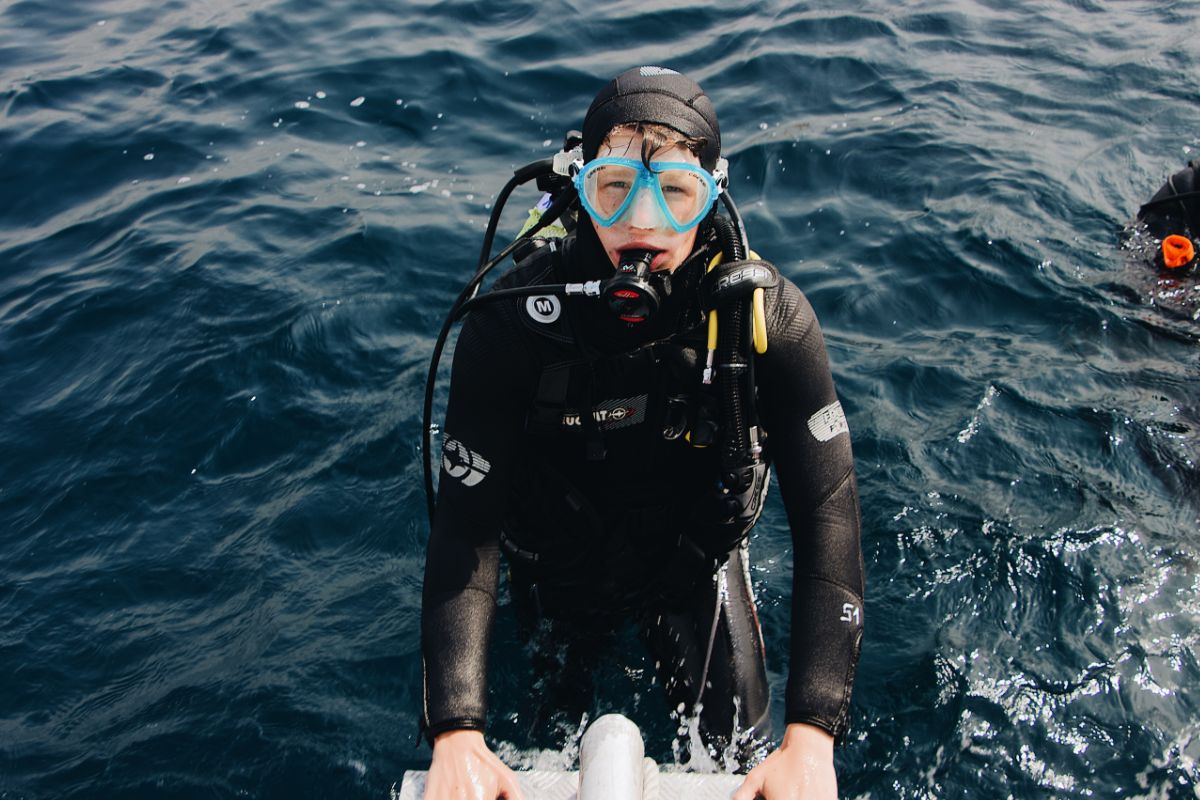Scuba diving is one of the most amazing activities one can do. Being able to swim at sea-bed level, observing some wonderful creatures, is a feeling like no other.
However, traveling to certain depths underwater means that there are changes in pressure, and therefore, you must adapt your body to those changes.

One of the most important parts of scuba diving is equalizing your ears. As you descend when you go diving, the pressure around you increases.
This is because water is a lot denser and heavier than air, and you can feel this pressure as you go deeper.
This article will be discussing the importance of equalizing as you go scuba diving, as well as how to perfect the Toynbee maneuver.
What Is Equalizing, And Why Should We Do It?
Equalizing is when you equalize the pressure inside your ears, to meet the pressure of your surroundings.
In our day-to-day lives, our ears are constantly equalizing to meet the external pressure of our surroundings, such as when we reach a certain altitude on a hike, etc.
However, being underwater is not something that the human body is well-adapted to, so your ears will struggle to equalize to the increased pressure on their own.
Therefore, when scuba diving, it is crucial that you learn how to equalize properly.
There are three parts to the ear – the inner ear, middle ear, and outer ear.
As you descend and water pressure increases, the eardrum gets compressed, pushing against the bones that are inside the middle ear.
You then must equalize the pressure of the middle ear in order to prevent the eardrum from pressing against the bones.
This is done by pushing air through the Eustachian tube into the middle ear, which, in turn, causes the eardrum to return to its original position.
At normal levels, the Eustachian tube is collapsed, but it opens up when you need to equalize pressure.
During this, you’ll notice a popping sound, which is a good indication that the tube is letting in more air.
Equalizing underwater requires more effort than it does in other circumstances.
This is because the pressure from the water is a lot higher than in other circumstances, so opening that tube is harder.
The Toynbee Maneuver
The Toynbee maneuver is a very simple way to equalize the ears during a dive.
It involves pinching your nose and swallowing at the same time. You must ensure that you are pinching your nose gently, in order to not hurt yourself.
As you swallow, it allows your Eustachian tubes to open, and the movement of your tongue as you swallow (with your nose blocked) compresses air, which then passes through the tubes to your middle air.
This, in turn, equalizes the dead air in your middle ears.
The Valsalva Maneuver
The Valsalva maneuver is probably the method that most people use when they first start diving.
It also involves pinching your nose gently, but instead of swallowing, you are to exhale through your nose, keeping your mouth closed.
This pushes the air from your sinuses into your ears, and you may hear a little ‘pop’ in your ears, which is normal.
You can also do this by pinching your nose, exhaling, and tilting your head to the left and right, as well as wiggling your jaw.
These actions will help the air go into your ears.
What Happens If You Don’t Equalize During A Dive?
As many divers have experienced before, especially at the start of their diving journey, failure to equalize properly will result in pain in the ear.
As mentioned earlier, the eardrum will be pushed inwards when there is too much of a difference between the pressure of the middle ear and external surroundings.
Sometimes, the Eustachian tube may not perform properly, which is why it needs assistance in equalizing.
However, if you are descending too quickly, the Eustachian tube may not be able to open properly.
If you continue to descend without equalizing both ears, you will experience pain in your ear, known by divers as an ‘ear squeeze’.
Tips For Equalizing

Now that you’re aware of how to use the Toynbee Maneuver, as well as the Valsalva Maneuver, here are a few tips on how to equalize properly.
Make Sure You Hear A Pop
Before making your way to the sea or pool, you should ensure that your ears are perfectly equalized to your surroundings by ensuring you can hear a pop in your ears as you swallow.
This signifies that your Eustachian tubes are open, meaning they are working properly, and you’ll have an easier time equalizing as you descend.
Begin Early
Begin equalizing the minute you start to descend. Do not wait until your ears feel uncomfortable. The minute your head goes under, begin equalizing gently.
This will minimize the risk of your ears blocking early on, which is when you may be occupied with other things, such as checking your surroundings.
Look Up
As you are equalizing, extending your neck can make this easier, as this position is said to open up your Eustachian tubes.
Use A Descent Line
Pulling yourself down using a descent line or an anchor will help you control the speed of your descent.
If during the descent you find that your ears aren’t equalizing, you should not, under any circumstances, carry on descending.
You should always halt in your descent, and perhaps swim up a foot or so to equalize your ears. This is much easier to do if you are holding on to a descent line.
Stay Ahead
Even if your ears have equalized properly, keep swallowing and pinching your nose every so often. This will prevent any blockages or pain from occurring.
Stop If You Feel Pain
As mentioned above, if you begin to feel any pain, you should stop immediately.
Continuing to descend will only cause more issues, so ascend slightly, and keep trying.
Avoid Diving If You Have A Cold
If you’re experiencing a cold, then you are likely to have more mucus affecting your sinuses, which leads to feeling blocked up.
It becomes difficult to equalize when you’re already blocked up, so you should only dive when you are feeling healthy and well.
Practice Makes Perfect
It is common for some divers to struggle when it comes to equalizing. Those who do would benefit from trying out and practicing using different techniques.
For some, the Valsalva method may not work as well, although it is very popular. Therefore, trying out the Toynbee technique may work better for them.
There are other ways to aid in your equalization, such as wiggling your jaw to each side and tilting your head back. This allows for more airflow to enter your ears.
Tilting your head while trying out these techniques is also a good way to loosen up your Eustachian tubes, allowing for your ears to equalize.
If you continue to have trouble equalizing after trying out all the techniques, it is best to abort the dive for that day, in order to avoid causing yourself pain.
Final Thoughts
In summary, the Toynbee Maneuver is a very effective method when it comes to equalizing your ears during a dive.
It involves pinching your nose gently, and swallowing until you hear a continuous popping sound in both ears as you swallow.
Aside from this technique, the Valsalva method is also very popular, with many people preferring it.
It involves pinching the nose and blowing out through the nose gently until you hear the popping sound.
Whichever method you choose, equalizing is one of the most important aspects of scuba diving. If it is not done properly, you risk damaging your eardrums.
If there is ever a case where your ears aren’t equalizing properly no matter how many things you try, you should abort the dive for that day.
- Is It Possible For A Shark To Swim Backwards? - August 2, 2022
- Are Leopard Sharks Dangerous? - August 2, 2022
- What Are The Differences Between Shark And Dolphin Fins? - August 1, 2022








